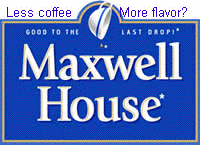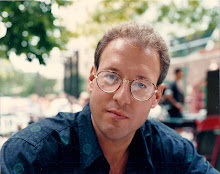 MarketingPost's Marketing Daily reports on a slide that began with the introduction of Starbuck's "Milder Dimensions". Even the name was prophetic of the company's future performance. I hope Howard Schultz gets back to the basics of just being some things to some people instead of trying to be more things to all people to restore his brand's equity and consumer's allegiance. Like I always said, "If I's ever wanted Milder Dimensions I would have gone to the grocery store and gotten some Maxwell House." But I didn't. I went to Starbucks because I liked good, dark, strong coffee. If I smoked cigarettes, it would be the equivalent of a filterless Lucky Strike or Chesterfield.
MarketingPost's Marketing Daily reports on a slide that began with the introduction of Starbuck's "Milder Dimensions". Even the name was prophetic of the company's future performance. I hope Howard Schultz gets back to the basics of just being some things to some people instead of trying to be more things to all people to restore his brand's equity and consumer's allegiance. Like I always said, "If I's ever wanted Milder Dimensions I would have gone to the grocery store and gotten some Maxwell House." But I didn't. I went to Starbucks because I liked good, dark, strong coffee. If I smoked cigarettes, it would be the equivalent of a filterless Lucky Strike or Chesterfield.

Tuesday, January 08, 2008
Starbucks Slows Ship, Begins Return To Safer Harbor
 MarketingPost's Marketing Daily reports on a slide that began with the introduction of Starbuck's "Milder Dimensions". Even the name was prophetic of the company's future performance. I hope Howard Schultz gets back to the basics of just being some things to some people instead of trying to be more things to all people to restore his brand's equity and consumer's allegiance. Like I always said, "If I's ever wanted Milder Dimensions I would have gone to the grocery store and gotten some Maxwell House." But I didn't. I went to Starbucks because I liked good, dark, strong coffee. If I smoked cigarettes, it would be the equivalent of a filterless Lucky Strike or Chesterfield.
MarketingPost's Marketing Daily reports on a slide that began with the introduction of Starbuck's "Milder Dimensions". Even the name was prophetic of the company's future performance. I hope Howard Schultz gets back to the basics of just being some things to some people instead of trying to be more things to all people to restore his brand's equity and consumer's allegiance. Like I always said, "If I's ever wanted Milder Dimensions I would have gone to the grocery store and gotten some Maxwell House." But I didn't. I went to Starbucks because I liked good, dark, strong coffee. If I smoked cigarettes, it would be the equivalent of a filterless Lucky Strike or Chesterfield.
Labels:
Chesterfield,
howard schultz,
Lucky Strike,
Milder Dimensions,
starbucks
Subscribe to:
Post Comments (Atom)










3 comments:
Where did the article reference it was making a lighter brew? I think Howard was making reference to building out retail experiences that were "watered down"
Andy
There's a lot wrong with Starbuck's "watered down" retail experience, starting with the first "watered down" products that it offered, "Milder Dimension" coffees, and continuing with extended menu offerings including dehydrated and reheated breakfast sandwiches for desperately hungry customers.
Starbucks literally "paved the way" for all of today's "copy cat" competitors by taking the easy new product and extension routes in its offerings...but not the correct ones.
For example. In 1959 Campbell Soup wanted to market a stew in a can to compliment its mainstay condensed soup business. That would have watered down the Campbell Soup Company's equity in SOUPS so I positioned the thick stew as "A SOUP YOU EAT WITH A FORK" forever crystalizing Campbell's as a soup company and establishing CHUNKY SOUP'S PERCEPTUAL MONOPOLY (tm). There has never been another Chunky Soup.
Starbuck's equity lay more in the love/hate relationship coffee drinkers had with the company's first offerings. New products and extensions did nothing to build this equity. By taking the easier, and apparently correct path to expanded menu offerings, candy bar beverages and Milder Dimensions, Starbucks put products on the shelf almost anyone could copy. By taking the harder route to explore darker dimensions and stronger dimensions, Starbucks could have more productively and profitably spent its time developing products that would have been harder to copy that thin-margin averse competitors would not have so easily started nipping away at market share.
Post a Comment